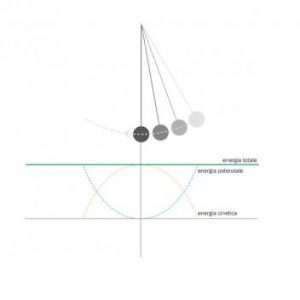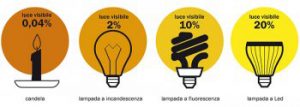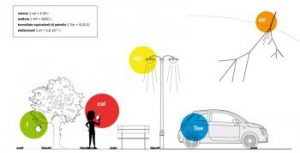The thousand faces of a physical quantity
by Paolo Gambino
The cosmic explosion at the beginning of time originated from a clump of energy. The incessant and incredible transformation of this primordial energy, its continuous dispersion and reaggregation, that’s what the history of the Universe is. So, in the beginning was the energy, and energy is light and mass, it is motion and heat, it is electricity and life. Physicists define energy as the capacity to do “mechanical work” (for example the energy contained in the petrol fueling a car), but energy is much more, and not all the energy can be completely converted to mechanical work. A pale reflex of the primordial energy moves are life too, illuminates and warmed up out nights, powers economy on the planet and hence the hopes of billions of people. The reflection on physical reality has always been accompanied – and often directly motivated – by the desire to give an answer to practical problems, in other words to provide technologies that can help humanity to satisfy its needs. Today, most of these needs (heat, movement, light, etc.) are satisfied through the exploitation of fossil fuel (oil, coal, natural gas). They are finite resources that are going, sooner or later, to run out and whose widespread use caused a rapid increase in carbon dioxide in the atmosphere which is altering the balance of the ecosystem. The early signals of dramatic climate changes are now evident and future development could be even worse: the transition towards sustainable energy sources has therefore become an urgent issue. This transition has already begun at global scale and it is highly likely that the fate of global warming depend on the speed at which it will be realized. So, what is energy? We talked about its changing and many-faced nature: in the history of physics, different shapes of energy have been subsequently identified and gradually included in a unifying process, culminating in the formulation of a universal principle of conservation according to which “the sum of all the energies of a closed system remains constant over time”.
 a.
a.
The total energy of an oscillating pendulum (assuming null friction forces) is constant (green line). This is the sum of kinetic energy (dotted yellow line) and potential energy (dotted blue line), that instead vary according to the pendulum position.
The first step towards understanding of energy was the emergence in the XVIII century of the “kinetic energy theorem” or “the theorem of live forces”, stating indeed the equivalence between kinetic energy, which is the energy a body has in accordance with is motion, and mechanical work, resulting from force by displacement. The force accelerating a rocket, for example, does a work equal to the kinetic energy acquired by the rocket. Now let’s consider a pendulum (see fig. a): during the oscillations its velocity (and therefore its kinetic energy) decreases when it rises upwards and it increases when it goes down. Therefore, it is natural relating the height achieved by the pendulum with a new kind of energy, “potential energy”, representing the capacity of a system to store energy through the interaction with something, in this case the gravitational field. The pendulum kinetic energy gradually becomes potential energy and vice versa, but their sum always remains constant. Indeed, there would be little point in talking in terms of energy if it was not conserved. According to the type of system we will distinguish between “gravitational” potential energy, like in the pendulum case, “elastic” potential energy, like the one of a spring, etc. But, if a pendulum is not touched, soon or later it stops: its energy is slowly dissipated through the friction of air and pin. Where does it go? It becomes heat and contributes to the “internal energy”, the energy of the pendulum microscopic components and of the air surrounding it, whose disorganized motion is related to the temperature of the system. The branch of physics which studies the relation between heat and work is called “thermodynamics”. Its first principle states again the conservation of total energy, while the secondo says it cannot transform all the heat absorbed by a system into mechanical energy.
Thermodynamics developed during the industrial revolution and its laws explain the behaviour of heat machines, that were constructed in those years. In particular, a heat machine, exchanging heat with a hot source and a cold one at absolute temperature T1 and T2, can never transform more than a 1-T2/T1 fraction of the heat absorbed into mechanical energy (Carnot’s theorem). This fraction is the “efficiency”, or the ratio between the useful and absorbed energies. The internal combustion engines of our cars, which consume petrol or diesel to produce the mechanical energy required for their motion/to move, have an efficiency of 25-30%: 70-75% of the energy is therefore dissipated into the environment as heat. Any energetic transformation at macro-level is characterized by an efficiency less than 1 and a heat dissipation into the environment (see fig. b). Of course, we also have both the electric and the magnetic potential energy: electromagnetic waves transfer precisely this kind of energy, that we perceive as light, heat or radiation depending on their wavelength. All bodies emit electromagnetic waves in proportion to the fourth power of their temperature: most of the metabolic consumption of our body, around 100 watt (1 watt, the unit of “power”, is equal to 1 joule per second), is emitted as infrared radiation. With the advent of relativity, we got some shattering news. The main one is that mass itself is a kind of energy (the famous Einstein’s mass-energy equivalence), as showed by the decay of radioactive nuclei and elementary particles or the matter-antimatter annihilation. The PET (the positron emission tomography, a diagnostic technique often used in medicine, especially for tumor localization and monitoring is based on this phenomenon: in the annihilation between an electron and a positron (the antiparticle of the electron) at rest, the energy of their mass totally turns into the electromagnetic energy of the two photons produced (two γ-rays). The mass-energy is immense: just one gram of matter contains more energy than the one released by the Hiroshima atomic bomb. In nuclear reactors a small part of the mass-energy is captured to produce electricity.
The mass-energy equivalence is true in the opposite direction too. In particle accelerators part of the energy of the colliding particles becomes mass-energy of the new particles, that after quickly decay. The recent discovery of the Higgs boson at LHC was possible precisely thanks to the high energy of the protons that are made collide in it. And since every particle is also a wave (as quantum mechanics teaches us), whose wavelength decreases with the increase of energy, high energy particles probe the structure of matter at very small distances, like high-powered microscopes.
Throughout the countless experimental confirmation of its conservation, energy remains an elusive concept – as Feynman said: “To this day, we really don’t know what it is” – whose essence must be seek in formal terms. Energy conservation is the reflex of the immutability of fundamental laws of nature, and so of the intelligibility of the world, the very mysterious property which allows us to get order from the chaos of the universe. And speaking of mysteries, we cannot fail to mention that, at cosmological level, the energy balance doesn’t seem to work: therefore, to explain the experimental observations, particularly the acceleration of the universe expansion, the existence of a vacuum energy was hypothesized, called “dark energy”, that represents one of the most fascinating topics of contemporary physics.
 b.
b.
The picture shows the emission efficiency of some luminous sources. In the case of a light bulb, the useful energy is the one emitted in the form of visible light, which is only a fraction of the energy used, because the remaining part is dissipated in heat or invisible radiation. LED (light emitting diode) lightning is a typical example of technology that, improving the efficiency, cuts down on energy consumption: in Turin, for example, the partial conversion to LED of public lightning reduced the related electricity consumption by 33% (25 million of kWh/year equivalent to 4 million euros/year).
Each second, the Earth receives 1.7 x 1017 joule of energy from the Sun, from which all forms of energy we know derive, both the renewable (solar, wind and water power) and the fossil ones (coal, oil and natural gas are nothing but fossil solar energy). Only tidal flows and geothermal heat have a different origin. A square metre of Italian soil, for example, receives an average of 170 watt of solar radiation: the total (final) energy consumed in our country in a year is equal to the solar energy reaching a square of side of just 30 km in the same period. Therefore, it is a very ample source, apparently at hand, and the same is true of wind, at least in the windiest regions. The problem is to transform those natural energy flows into the form of energy we need (electrical, thermal, etc.) so that we can use it when necessary. The main restrictions are related to the efficiency of the transformation process, to the fluctuations (daily, seasonal and random) of those flows and to the cost of the corresponding installations. A common silicon PV panel, for example, transforms solar energy into electrical energy with around 15-17% efficiency (the best models on the market reach 22%) and hence just a small part of the solar radiation can be converted into electrical energy. New technologies could increase efficiency, but there are some insurmountable physical limits (about 29% for single junction silicon cells). We can, however, much more effectively heat the water by Sun: a solar collector has an efficiency which depens on the difference between water temperature and the one of the environment, and it is typically 50-60% for water temperatures of about 60°C. Obviously, the value we attach to the efficiency depends on the cost: the good news is that the price of traditional PV has dramatically decreased over recent years, to the point where modules are no longer the principal cost item in the construction of a small plant. And also the price of wind energy has fallen, even though slowly.
 c.
c.
PV panels transform solar radiation into electrical energy. The dominant technology is based on the use of silicon, a material which is very abundant in nature, and it has a modest efficiency, between 15 and 22%. Its cost has been dropping over the past 10 years. The search for even cheaper and more efficient alternatives is extremely active.
The result, at global level, is a boom of these two renewable sources, which in several areas no longer need incentivization and that now often compete with fossil energy sources. At the end of 2016, there were about 300 GW from photovoltaic plants and 500 GW from windmills installed worldwide. The energy transition affects the whole planet and proceeds with great speed: the International Energy Agency (IEA) estimates that in 2016 24% of the global electricity was produced by renewable sources, a share expected to exceed 30% by 2021. Now in Italy it firmly stands around 33%, that is double the number for 2008. Nevertheless, these sources are not programmable, and their unpredictability and seasonality represent a serious problem for the future electricity networks, only partially mitigated by the potential of programmable renewable sources such as biomass. The accumulation of energy (of both short and long duration, thermal, mechanical or chemical) is therefore at the heart of current research, but also the electricity network and the way we use energy are expected to change deeply, displacing part of the consumption to those periods with maximum availability of renewable energy. In parallel, the improvement of energy efficiency has great potential. Consider thermal energy consumption which in Italy accounts for 45% of the total: improving thermal insulation of buildings and extending teleheating can contribute to reduce them significantly. The transport sector, globally absorbing almost a third of the energy, is primarily based on diesel and petrol engines, that – as we were saying – are underperforming. An electric engine, instead, has a yield around 90% and enables the recovery of under braking energy too. The widespread use of electric cars and in general the electrification of transport are therefore essential parts of any future energy scenario based on renewable fuels. Technology is now mature and it is estimated that by 2030 there will be 150 million of electric cars circulating. So, the improvement of energy efficiency is complementary to the use of renewable sources in the frame of a strategy to reduce emissions and requires an investment whose time to recovery is often short. Since the resulting savings is very competitive as compared with the construction of new power plants, at global level we see a strong expansion of these investments (EUR 200 billion only in 2015). Today every Italian consumes on average about 80 kWh per day of primary energy, in other words he averagely absorbs 3.3 kW. Those are for warmth, at home and the office (for over 20% of the total), to move, eat, work and have fun and to produce consumer articles, from cars to mobile phones. Running a kilometer with a petrol or diesel car, for example, requires almost 1kWh of primary energy, 5-10 times more the electricity absorbed by an electric car. A commercial airliner Turin-Rome consumes around 50.000 kWh and about 200 kWh per passenger. Travelling by train, including a high-speed one, is at least ten times better! Besides the improvement of efficiency and the elimination of wastage there are also lots of possibilities of saving energy but these imply some changes in our lifestyle (e.g. using a bicycle instead of a car). Unfortunately, the pace of energy transition is still insufficient to have an impact on the current climate changes, and to cut down CO2 emissions on an adequate scale to limit the average temperature increase to 2°C. The global demand for energy, led by the world population growth, continues to increase indeed. Only in advanced economies it is noted a slight but constant decrease since the early 2000s, partly due to efficiency gains. If in the immediate future priority should be to reduce emissions and consumptions, by increasing the share of renewable sources, over the medium to longer term the development of new renewable and nuclear technologies – such as fusion and inherently safe fission – could play an important role. In the end, although energy transition has already started, we still do not know exactly where it will take us, even if it will certainly have a significant impact on society and economy. In fact, it would be wrong to view the energy problem just as a technological problem: it is also, and perhaps more importantly, a political and cultural issue. Without a very extensive education towards a responsible use of energy and without rediscovering the value of moderation, the best technologies, probably, will not be enough.
 d.
d.
According to the International System the measurement unit of energy is the joule (J) but, depending on the context, you often use different practical units: to measure the quantity of heat we use the calorie (cal, equal to 4.19 J), electricity consumptions are expressed in watt-hour (Wh, equal to 3600 J), while to express the energy produced by fossil fuel we use the equivalent ton of oil (Toe, conventionally considered equal to 10 Gcal = 41.9 GJ); finally, the energy of elementary particles is expressed in electron volt (eV, equal to 1,6 x 10-19 J).
So the potential energy of a 100 g apple hanging at a height of one metre (energy which is found as kinetic energy when the apple, falling, touches the ground) is around 1 J; the same apple, consumed as food, provides an energy content of about 50 kcal = 209 kJ; a 1000 W street lamp consumes 1000 Wh, equal to 3600 kJ, in an hour; a 60 litre tank of gas corresponds to about 0,05 Toe, equal to 2 GJ; the most energetic cosmic rays ever observed reach energy higher than 1020 eV (10 million times the energy of the protons in LHC), corresponding to just a few tens of joule.
Translation by Camilla Paola Maglione, Communications Office INFN-LNF
 INFN-LNF Laboratori Nazionali di Frascati
INFN-LNF Laboratori Nazionali di Frascati
